A last-minute reminder that today, Friday, September 30th is the last day to "submit your research project, your innovative green roof project, or your green roof idea to the Green Roofs for Healthy Cities committees for review. Composed of industry professionals, researchers and experts, the GRHC Committee members will jury all submissions for acceptance in our International Conference." Submission requirements: A 300-word abstract and 50-word biography by September 30, 2005. See details at www.greenroofs.org or email jphilp@greenroofs.org."
"The fourth annual Greening Rooftops for Sustainable Communities Conference, Awards, & Trade Show, May 10-12, 2006 in Boston, will bring together experts from diverse fields across North America, and around the world. The conference will raise awareness of the many benefits of green roofs, share new research findings and provide information on the latest designs, implementation techniques and products. It is a great opportunity to broaden networks and develop new business contacts while building more sustainable cities through green roof implementation."
A daily blog on architecture in Chicago, and other topics cultural, political and mineral.
Click on the COMMENTS link under each post to join the discussion.
Friday, September 30, 2005
Wednesday, September 28, 2005
Signs of Life outside the MCA
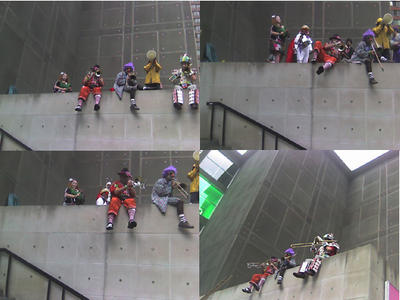
Courtesy of Edward Lifson of WBEZ's Hello Beautiful, here a few shots of this past Sunday's Musicircus, which provided a touch of humanity, however briefly, to the grave haunches of the building housing Chicago's Museum of Contemporary Art, designed by the late Joseph Paul Kleihues. The work was first created by composer John Cage in 1967, since which it's been put on throughout the world, but Sunday's performance represented it's Chicago premiere.
Monday, September 26, 2005
The Chicago Symphony at Gehry's Pritzker Pavilion - There IS a Difference
Classical music in American, like pretty much everything else, is increasingly about marketing. Very fine ensembles, often in the suburbs, market proximity, price and informality as much as music they play. It's just too much of a hassle to trek down to the Loop to attend Chicago Symphony concerts, they assure us. The suburban counterparts are "good enough," and a lot more convenient. This, of course, is like a Roman saying they've never visited the Sistine Chapel because the parking is better at the local parrish. Read about it here.
Saturday, September 24, 2005
Alert: new Stand competition registration deadline is October 1st
Information on the new Stand competition sponsored by Architecture for Humanity Chicago here. The inexhaustible Stanley Tigerman will head the jury, which will also include Patricia Saldana Natke and Henry L. English
Friday, September 23, 2005
Architecture's Fall Season Begins With a Bang Next Week
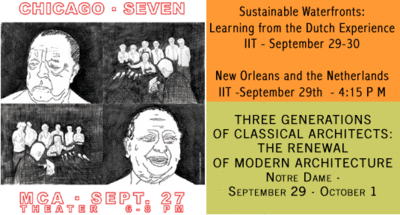 Return of the Chicago Seven
Return of the Chicago SevenThis Tuesday, September 27th, at the Museum of Contemporary Art - a reunion of the Chicago architects who challenged and overthrew the hegemony of Mies's followers. Information.
New Orleans and the Netherlands: Living Below Sea Level
A special panel discussion added to the Sustainable Waterfronts conference at IIT. Panel includes Dico van Ooijen, senior advisor for dikes and dams of the Netherlands Ministry of Transport, Public Works and Water Management, Peter Torbijn, director of national spatial planning policy and advisor to the Dutch Minister of Housing, Spatial Planning and the Environment, Larry J. Prather, assistant director of civil works, U.S. Army Corps of Engineers and Dave Sanford, director for navigation policy and legislation of the American Association of Port Authorities. Information.
Three Generations of Classical Architects: The Renewal of Modern Architecture
A three-day conclave of classicists at the School of Architecture at Notre Dame. The extensive roster of announced speakers and panelists includes Robert Adam, Thomas Beeby and Leon Krier. Information
Wednesday, September 21, 2005
The Death of Marshall Fields and the Dissolution of The Sense of Place
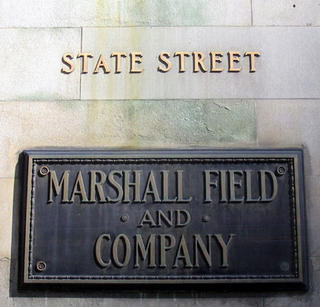
Finally, the deed is done. Yesterday, Federated Department Stores announced that all of the stores of Marshall Field's, a Chicago institution for over a century and, with Wanamaker's, one of the two creators of the concept of the department store in America, would be converted to Macy stores in 2006.
From their inception, department stores were like a museum, a riverfront, a memorial, or a stadium - something that defined the unique character of a city. Now they're just roadkill in Wal-Mart America. A look at Field's recent history helps explain just how this happened, and what it may mean for the future of America's cities. Read it here.
Tuesday, September 20, 2005
Dutch Symposium at IIT to add program on New Orleans and the Dutch experience at Holding Back the Sea
When hurricane-force winds broke through the barriers, the result was a catastrophic flood that killed over 1,800 people, destroyed over 3,000 homes, and left over 700 square miles under water. However, the place was not 2005 New Orleans, but The Netherlands, circa 1953. Like New Orleans, large amounts of its territory is below sea level, and the country's survival down through the centuries is a direct result of what it's learned about keeping out the sea. (Read more here.)
Now, the organizers of Sustainable Waterfronts, Learning from the Dutch Experience, a symposium to be held at IIT on September 29th and 30th, have added a panel discussion for September 29th - time still to be announced - considering the Dutch experience and the challenges facing New Orleans as it rebuilds.
Participants will include:
- Dico van Ooijen from the Netherlands Ministry of Public Works and Water Management who will show the efforts of the Dutch since the flooding in 1953 to protect their country from a recurrence.
- An official from the Dutch Ministry for the Environment and Spatial Planning who will talk about the planning and environmental impacts in the Netherlands where a large part of the country is below sea level.
Two American participants are expected to be added shortly.
More information on the symposium and registration here.
Now, the organizers of Sustainable Waterfronts, Learning from the Dutch Experience, a symposium to be held at IIT on September 29th and 30th, have added a panel discussion for September 29th - time still to be announced - considering the Dutch experience and the challenges facing New Orleans as it rebuilds.
Participants will include:
- Dico van Ooijen from the Netherlands Ministry of Public Works and Water Management who will show the efforts of the Dutch since the flooding in 1953 to protect their country from a recurrence.
- An official from the Dutch Ministry for the Environment and Spatial Planning who will talk about the planning and environmental impacts in the Netherlands where a large part of the country is below sea level.
Two American participants are expected to be added shortly.
More information on the symposium and registration here.
Monday, September 19, 2005
Venturi Lecture Tops Architecture Events at 2005 Chicago Humanities Fest
Mies is More - Learning from Mies is name of a lecture to be given by Robert Venturi at IIT on Wednesday, November 9th as part of the 2005 Chicago Humanities Fest. Coming from the guy who coined the immortal retort, "Less is a bore", and who, along with partner Denise Scott Brown continues to confound and expand conventional architectural thinking, this event stands to be one of the highlights of the season. Tickets are free, but reservations have to be made through the festival here. Today, Monday, September 19th, marks the first day the general public can register for Humanities Fest events and buy tickets.
Unfortunately, the appearance by Shigeru Ban appears to have been cancelled, but other events include:
Saturday November 5th -
The Avant-garde Interiors of Francis Elkins, a lecture by Stephen M. Salny. Author of Frances Elkins: Interior Design, discusses the work of Elkins, who was also the sister of architect David Adler.
Sunday, November 6th
The Perfect Houses of Andrea Palladio, lecture by Witold Rybczynski. There will also be an event offering a discussion of Rybczynski's work.
Saturday, November 12th
Public Housing Beyond the Walls is a panel discussing "the importance of stable, affordable housing for low-income families."
Sunday, November 13th
Re-Placing Home is a lecture by Roberta Feldman, co-director of the City Design Center at UIC on the "meaning of home and its diverse physical representation in our mobile society." Feldman is also curator of the Out of the Box exhibition on pre-fab housing currently at Chicago's Field Museum.
The Festival includes over 180 events across all art forms, most either free or no more than $5.00. It includes scheduled appearances by Salman Rushdie (already sold out), Joan Didion, Adam Gopnik, Charlayne Hunter-Gault, Susan Orleans, Mia Farrow, Martin E. Marty, Rachel Barton-Pine, Elizabeth Futral, and Timuel D. Black, Jr., to name just a few. View all programs here.
Unfortunately, the appearance by Shigeru Ban appears to have been cancelled, but other events include:
Saturday November 5th -
The Avant-garde Interiors of Francis Elkins, a lecture by Stephen M. Salny. Author of Frances Elkins: Interior Design, discusses the work of Elkins, who was also the sister of architect David Adler.
Sunday, November 6th
The Perfect Houses of Andrea Palladio, lecture by Witold Rybczynski. There will also be an event offering a discussion of Rybczynski's work.
Saturday, November 12th
Public Housing Beyond the Walls is a panel discussing "the importance of stable, affordable housing for low-income families."
Sunday, November 13th
Re-Placing Home is a lecture by Roberta Feldman, co-director of the City Design Center at UIC on the "meaning of home and its diverse physical representation in our mobile society." Feldman is also curator of the Out of the Box exhibition on pre-fab housing currently at Chicago's Field Museum.
The Festival includes over 180 events across all art forms, most either free or no more than $5.00. It includes scheduled appearances by Salman Rushdie (already sold out), Joan Didion, Adam Gopnik, Charlayne Hunter-Gault, Susan Orleans, Mia Farrow, Martin E. Marty, Rachel Barton-Pine, Elizabeth Futral, and Timuel D. Black, Jr., to name just a few. View all programs here.
Friday, September 16, 2005
Zoka Zola profile in this week's Chicago Reader
There's a great profile in this week's Reader by Dennis Rodkin on Chicago architect Zoka Zola: her life, work, philosophy, and the origins of her highly alliterative name. Pick up a copy or download it in Adobe Acrobat form here.
Architectural Exhibition at Oak Park Public Library

An exhibition organized by the Oak Park Architectural League is on display at the village's Public Library through September 30th. The show highlights the work of 23 Oak Park architects, and includes Annuradha and Arun Gandhi's entry, pictured to the left, to the Chicago Architectural Club's 2004 Burnham Prize competition for a series of three water taxi stations along the Chicago river.
Wednesday, September 14, 2005
The Return of the Chicago Seven
In 1976, just as Mayor Richard J. Daley controlled Chicago, the legacy of Mies van der Rohe was seen as controlling new architecture in the city, even though the master had died in 1969. When the Musuem of Contemporary Art's exhibition One Hundred Years of Architecture in Chicago squeezed the history of the preceding century through a forced Miesian and monumentalist perspective, provocateur Stanley Tigerman led a group of younger architects in mounting a counter-exhibition, Chicago Architects, where the work displayed a creativity and freedom that directly challenged the orthodoxy and dominance of Mies's followers. The group, expanded to include Tom Beebe, Larry Booth, Stuart Cohen, Jim Freed, Jim Nagle, and Ben Weese, became known as the Chicago Seven, an homage to the radicalism of the anti-war activists put on trial in the city in 1970. Several other historic shows followed, and many of the same crowd were instrumental in reviving the long dormant Chicago Architectural Club.
On September 27th, the Museum of Contemporary Art is hosting a panel, Celebrating 25 Years of the Chicago Seven, that hopes to reunite those seven architects. It beats still another Stones reunion hands down. Information here.
On September 27th, the Museum of Contemporary Art is hosting a panel, Celebrating 25 Years of the Chicago Seven, that hopes to reunite those seven architects. It beats still another Stones reunion hands down. Information here.
Great Blair Kamin reporting from New Orleans - what the city could learn form Chicago
There's a splendid extended article in today's Chicago Tribune by architectural critic Blair Kamin on the present state and potential future of New Orleans. His first hand report talks about what it's like to be a solitary tourist in a largely abandoned city, and talks about how much more of the city endured than reports have indicated. He makes a strong case for the rebuilding of New Orleans, both its feasibility and its necessity. Kamin talks about how reversing the flow of the Chicago river, to avoid the contamination of the lake and its drinking water, is just one concrete example of how a city triumphed over nature. If you can, pick up a copy of the paper so you can also see Chris Walker's great photos. If you can't, you can reader Kamin's account, free for the next seven days, here.
An even more cogent example, and one which I've yet to hear anyone discuss, is that in its early history Chicago almost drowned in its own muck and filfth, with regular and vicious outbreaks of cholera until the decision was made in 1850's to raise the level of the entire city six to ten feet. You can still see it clearly in the old neighborhood houses where stairs lead down to what used to be the entrance, and especially along the riveredge of the Loop, where you can clearly see how the current level of the streets are over a full story over ground level. Lower Wacker Drive is where Chicago's "natural" level lies.
As New Orleans is rebuilt, why can't we do something similar to raise its lower districts back above sea level?
An even more cogent example, and one which I've yet to hear anyone discuss, is that in its early history Chicago almost drowned in its own muck and filfth, with regular and vicious outbreaks of cholera until the decision was made in 1850's to raise the level of the entire city six to ten feet. You can still see it clearly in the old neighborhood houses where stairs lead down to what used to be the entrance, and especially along the riveredge of the Loop, where you can clearly see how the current level of the streets are over a full story over ground level. Lower Wacker Drive is where Chicago's "natural" level lies.
As New Orleans is rebuilt, why can't we do something similar to raise its lower districts back above sea level?
Tuesday, September 13, 2005
Children's Fountain Back - in Black?




The Children's Fountain, a project of former Chicago mayor Jane Byrne, has been restored and reconstructed in front of the Chicago Historical Society, at the northeast corner of Clark and North. Dedicated in 1982, it had stood in a traffic island at Wacker and Wabash until it was dismantled, along with the same mayor's Vietnam Veterans Memorial (reportedly the first to honor that conflict's servicemen) for the 2001 rebuilding of Wacker Drive. According to the Building Blocks, Inc. website, the fountain was crated up by the reconstruction's contractor and stored under the Roosevelt Road Bridge, where it stayed for four years.
The restored fountain sits on a graceful new granite base, just across the street from the Latin School and Moody Church. The one glaring defect in the restoration is that the current finish, described on Building Blocks as "Antique Green 'Verde Grie' appears much darker than the original, which was a much lighter green both in memory and in photographs here, here, and here. Now, it's so dark that, even on a sunny day, it seems to suck in all the light, making it extremely difficult to see the ornate detailing, and giving what was a very playful fountain a heavy, funereal air.
Monday, September 12, 2005
Smash the Birdie

Migratory bird season is here again in Chicago, sometimes described as the "O'Hare of migratory birds." It's not a happy time for countless birds who meet their end smashing into Chicago's glass-walled buildings, so we're going into the vault for a story on an April, 2004 symposium where activists and experts like architect Jeanne Gang, Robbie Hunsinger of Chicago Bird Collision Monitors and David Baker of IIT talked about the problem and what they were doing about it. With September, 2005 updates. Read all about it here.
Saturday, September 10, 2005
A Bit of low rent Blade Runner comes to Marina City
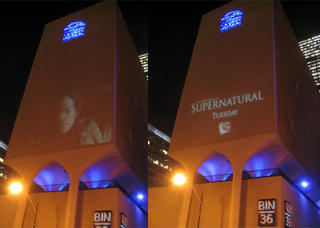 September 9, 2005 - a projected billboard on the Dearborn Street elevation of Bertrand Goldberg's Marina City office building, now the House of Blues Hotel.
September 9, 2005 - a projected billboard on the Dearborn Street elevation of Bertrand Goldberg's Marina City office building, now the House of Blues Hotel.
Friday, September 09, 2005
Can the Children's Winery be Far Behind?


The grape vines have wasted no time in claiming their place along the facade of Chicago's elegant new Lincoln Park Pritzker Family Children's Zoo, designed by Marc L'Italien of EHDD.
Thursday, September 08, 2005
Classicists and the Dutch descend to save us

Two big conferences are coming up at the end of September. The Dutch Consulate and a number of other sponsors are hosting Sustainable Waterfronts, Learning from the Dutch Experience at IIT September 29-30. At the same time, for all of us who want to crawl back into the womb (and considering the way things have been going, who wouldn't?) the School of Architecture at Notre Dame is sponsoring a three-day conference Three Generations of Classical Architects, which will feature such luminaries as Robert Adam and Leon Krier.
Wednesday, September 07, 2005
Art Deco jewelbox Veseman Building gets preliminary landmark designation
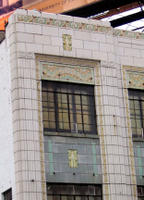
The Veseman Building, a 1930 art deco gem with polychromatic terra cotta in floral motifs, has just received preliminary Chicago landmark designation. Read more here.
Tuesday, September 06, 2005
Mies Resurrected
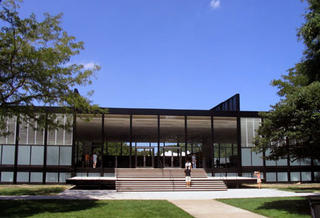
Mies van der Rohe's modernist masterpiece Crown Hall, on the Chicago IIT campus that he also designed, has just reopened after the most radical restoration in its 50 year history. Read all about it here. (This story originally appeared in the Chicago Reader in different and more manageable form under the title, Sweet Nothing, September 2nd, 2005.)
The Legacy of Crown Hall

Crown Hall and Mies van der Rohe, a shining beacon on the road to modernism or, as Tom Wolfe would suggest, a vampiric infestation of dead European values into the pristine American midwest. Some initial thoughts. Be sure to add your own here.
Monday, September 05, 2005
"Who Cares?" Sundays continue at WFMT
On this Sunday's Chicago Symphony Retrospective, the final announced work was Brahm's Fourth Symphony, which, run through WFMT's automated mixmaster, began with the final movement of the Bruckner 9th, followed by the final three movements of the Brahm's. No one caught the error, or fixed the error, or even acknowledged it. The announcers-in-a-can remained blissfully oblivious, a perfect mirror of the attitudes of current management.
Saturday, September 03, 2005
Katrina
Chicago Helps
The American Red Cross
The Salvation Army
Archinect has set up a disaster relief/adopt an architect web page here. Tulane University in New Orleans has cancelled its fall semester and is working to help its students to enroll as temporary students at other institutions.
Locally, IIT also has a web page up for support, and with information for students displaced by Katrina who are "interested in transferring to IIT" The University of Illinois at Champaign Urbana is also working to assist displaced students. Contact the Office of Admissions and Records at 217/333-0302.
And if you are as outraged by the complacency, misplaced economies and lack of preparation of our leaders as you are blown away by the bravery and selflessness of the rescue workers, medical personnel, and guardsmen, record exactly how you feel today in a note, and paste it into your calendar for the dates of November 6th, 2006, and November 3rd, 2008.
The American Red Cross
The Salvation Army
Archinect has set up a disaster relief/adopt an architect web page here. Tulane University in New Orleans has cancelled its fall semester and is working to help its students to enroll as temporary students at other institutions.
Locally, IIT also has a web page up for support, and with information for students displaced by Katrina who are "interested in transferring to IIT" The University of Illinois at Champaign Urbana is also working to assist displaced students. Contact the Office of Admissions and Records at 217/333-0302.
And if you are as outraged by the complacency, misplaced economies and lack of preparation of our leaders as you are blown away by the bravery and selflessness of the rescue workers, medical personnel, and guardsmen, record exactly how you feel today in a note, and paste it into your calendar for the dates of November 6th, 2006, and November 3rd, 2008.
Friday, September 02, 2005
NY Crix Nix MvdR Hootch Licks
New York City's Skyscraper Museum has published the results of a survey it made asking 100 architects, engineers, developers, critics, planners and others of their ilk to name their favorite New York skyscrapers. The clear first place winner was the Chrysler Building, with 90 votes, but silver and bronze were taken by buildings designed by Chicago firms. Mies van der Rohe's 1958 Seagram Building claimed 76 votes, and Daniel Burnham's 1903 Flatiron got 73, placing it in a tie with Cass Gilbert's Woolworth tower.
Although World Trade Center Kapellmeister David Childs scratched Mies completely off his list, the Seagram scored strongly across all categories, except for the critics. Four out of six turned up their noses and didn't include the Seagram anywhere in their top ten, and the New Yorker's Paul Goldberger make a point of listing it sixth. (To be fair, Goldberger's iconoclastic top choice was the frequently overlooked 70 Pine Street, a sleek Art Deco masterpiece from 1932, the last major skyscraper to be built in the financial district until 1961, that is again, after September 11th, the third tallest building in Manhattan.)
In early public voting, the Chrysler is again the overwhelming favorite, while the Seagram is dead last. You can vote your own choice here.
The website has posted a complete table of all of the 100 professional responses, which includes the picks of local architects Helmut Jahn and Adrian Smith, former native Mike Wallace, and adopted son The Donald, who remains in character by ignoring all 25 official nominees and picking only four buildings, which coincidentally turn out to all be Trump projects.
Although World Trade Center Kapellmeister David Childs scratched Mies completely off his list, the Seagram scored strongly across all categories, except for the critics. Four out of six turned up their noses and didn't include the Seagram anywhere in their top ten, and the New Yorker's Paul Goldberger make a point of listing it sixth. (To be fair, Goldberger's iconoclastic top choice was the frequently overlooked 70 Pine Street, a sleek Art Deco masterpiece from 1932, the last major skyscraper to be built in the financial district until 1961, that is again, after September 11th, the third tallest building in Manhattan.)
In early public voting, the Chrysler is again the overwhelming favorite, while the Seagram is dead last. You can vote your own choice here.
The website has posted a complete table of all of the 100 professional responses, which includes the picks of local architects Helmut Jahn and Adrian Smith, former native Mike Wallace, and adopted son The Donald, who remains in character by ignoring all 25 official nominees and picking only four buildings, which coincidentally turn out to all be Trump projects.
Thursday, September 01, 2005
Last 4 Days to See Peter Behrens Dining Room

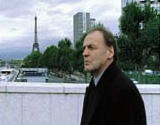
I finally got up to Milwaukee to see Santiago Calatrava's spectacular Milwaukee Art Museum. More of that later. However, a quick heads up on two exceptional exhibitions, both in their last days, that are definitely your while. The Arts and Crafts Movement in Europe and America, 1880-1920: Design for the Modern World runs only through September 5th. It's a country-by-country assembling of objects that include a George Maher fireplace and an entire dining room, from wallcoverings and carpet down to furniture, linens, cutlery and glassware, designed by Peter Behrens for the Wertheim Department store. Beginning October 16th, the show will move to The Cleveland Museum of Art, where it'll run until January 8th of next year. You have only a bit more time to catch another extraordinary show at MAM, Cut/Film as Found Object, in which 14 artists take existing films and transform them into their own artworks. I'll be writing later on the architectural aspects of Pierre Huyghe's "L'Ellipse" which depicts what takes place between two cuts in Wim Wenders 1977 movie, The American Friend, using the same actor, Bruno Ganz, twenty years later. The show will be up through September 11th.


